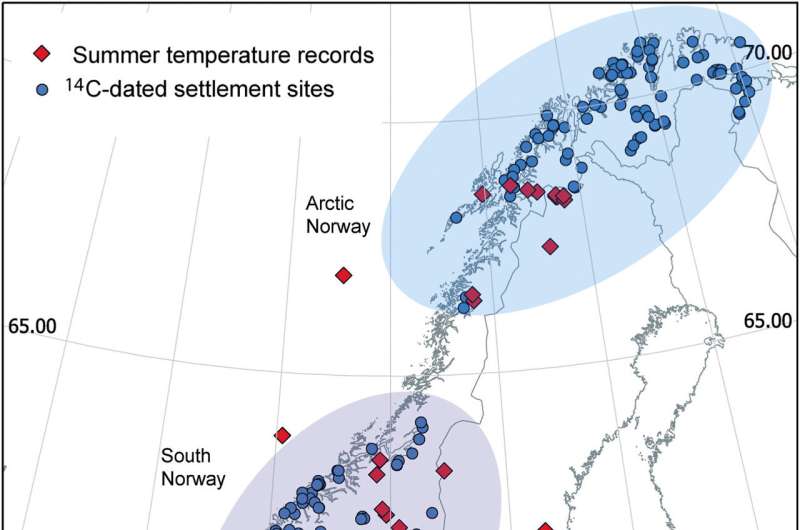This article has been reviewed according to Science X's editorial process and policies. Editors have highlighted the following attributes while ensuring the content's credibility:
fact-checked
peer-reviewed publication
proofread
How early farmers in Scandinavia overcame climate change

As the world faces the challenges of present-day climate change, scientific inquiry is, among other objectives, exploring how human societies navigate environmental variations at large. Investigating the past provides valuable insights into this.
A new study, published by researchers from the ROOTS Cluster of Excellence at Kiel University, together with colleagues from Oslo, Tromsø, and Stavanger (Norway), in the journal Quaternary Science Reviews presents an unprecedentedly extensive set of archaeological and environmental data revealing connectivities between climate changes, population dynamics and cultural changes in present-day Northern Germany and Scandinavia during the Neolithic and Early Bronze Age (approximately 4100 to 1100 before common era).
"Contrary to the notion that societies were passive recipients of environmental shifts, the study reveals that these ancient communities developed sophisticated strategies to navigate and adapt to changing conditions," says Dr. Magdalena Bunbury, the study's lead author.
The study, which leveraged an unprecedentedly extensive set of archaeological data, utilized carbon isotope analysis to date traces of human activities within the research area. The authors gathered more than 20,000 14C samples from the past 17,000 years. After rigid quality control, 6,268 remained being valuable for the study. "Using multiple statistical approaches, we can reconstruct whether population numbers increased or decreased during specific epochs," explains Dr. Bunbury.
"We also analyzed 49 high-resolution climate archives from between 50 and 70 degrees north latitude, enabling a detailed reconstruction of environmental conditions in the study region between 4100 and 1100 BCE," adds co-author Dr. Mara Weinelt from the ROOTS Cluster of Excellence, who initiated the study. In addition, the team incorporated archaeological information about more than 3,600 houses from nearly 1,500 sites across most of the study area.
Based on this extensive dataset, the findings of the study underscore the nuanced relationship between regional climate trends and local adaptations. For instance, a pronounced Holocene warm period between approximately 7050 and 2050 BCE in Scandinavia, had varying impacts depending on latitude.
"In Southern Scandinavia, this warmer climate might have facilitated the spread of agriculture in the early 4th millennium BCE, coinciding with a significant population growth," says Dr. Bunbury, who researched as a postdoctoral fellow at the ROOTS Cluster of Excellence until 2022 and is now working at James Cook University in Cairns, Australia.
A cooling trend around 2250 BCE marked the onset of a climate shift that varied in duration and timing across latitudes and regions within the study area. Neolithic communities in Southern Norway, despite facing cooling trends, demonstrated resilience by continuing to grow and settling in the region.
Simultaneously, in Denmark, people cultivated a greater variety of crops and developed houses capable of storing harvests for longer periods. "These processes can be interpreted as clear adaptations to changing environmental conditions," explains co-author Dr. Jutta Kneisel from Kiel University.
In the frigid expanses of Arctic Norway, a distinctive approach emerged. Instead of immersing themselves in large-scale farming, the communities turned to foraging—the gathering of food from nature—as their preferred survival strategy. "Rather than intensifying their agricultural pursuits, Arctic Norwegian communities demonstrated strategic acumen by diversifying their economic activities to mitigate risks," Dr. Bunbury further elucidates.
The study further delves into the 2nd millennium BCE, revealing abrupt cooling periods and corresponding declines in population numbers. The corresponding data indicates concurrent short-term declines in population numbers. Archaeological findings suggest interruptions in trade networks with Continental Europe.
After these short-term cooling periods, the population began to grow again from the middle of the 2nd millennium and developed a new, stable house form.
"We cannot attribute all changes in human societies to climate. However, the data clearly show significant links between population development, habitation, and economic practices on one hand, and climate trends on the other. Especially the recovery of population numbers after abrupt cooling events in the 2nd millennium is a clear indication of the resilience or adaptability of early societies in Scandinavia to climate variability," says Dr. Weinelt. Further investigations focusing on smaller regions could yield more insights into the connection between humans and the environment.
More information: Magdalena Maria Elisabeth Bunbury et al, Understanding climate resilience in Scandinavia during the Neolithic and Early Bronze Age, Quaternary Science Reviews (2023). DOI: 10.1016/j.quascirev.2023.108391
Journal information: Quaternary Science Reviews
Provided by Cluster of Excellence ROOTS - Social, Environmental, and Cultural Connectivity in Past Societies



















